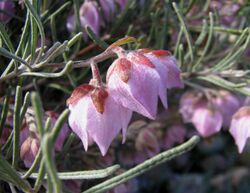Biology:Guichenotia macrantha
| Large-flowered guichenotia | |
|---|---|

| |
| Scientific classification | |
| Kingdom: | Plantae |
| Clade: | Tracheophytes |
| Clade: | Angiosperms |
| Clade: | Eudicots |
| Clade: | Rosids |
| Order: | Malvales |
| Family: | Malvaceae |
| Genus: | Guichenotia |
| Species: | G. macrantha
|
| Binomial name | |
| Guichenotia macrantha Turcz.[1]
| |
Guichenotia macrantha, commonly known as large-flowered guichenotia,[2] is a species of flowering plant in the family Malvaceae. It is a shrub with grey-green leaves, mauve flowers and is endemic to Western Australia.[2]
Description
Guichenotia macrantha is an open, upright, or sometimes a straggling small or tall shrub to 1–2 m (3 ft 3 in–6 ft 7 in) high, 1.5–2 m (4 ft 11 in–6 ft 7 in) wide with new growth covered in star-shaped hairs. The leaves are linear to oblong shaped, upper surface grey-green, 20–95 mm (0.79–3.74 in) long, 1.5–2 mm (0.059–0.079 in) wide, margins rolled under, lower surface yellowish-green, wrinkled, thickly hairy, rounded apex on a petiole 2–3 mm (0.079–0.118 in) long. The calyx lobes are mauve, pink-purple, sometimes white, each lobe with three distinct ribs, 1.5–2.5 cm (0.59–0.98 in) in diameter, divided to halfway, petals deep red, small, pedicel 8–15 mm (0.31–0.59 in) long and peduncles 18–50 mm (0.71–1.97 in) long. The bracts are leaf-like, oval-shaped, 8–12 mm (0.31–0.47 in) long, 1–2 mm (0.039–0.079 in) wide and borne at the base of each pedicel. Flowering occurs from May to September and the fruit is a woody, elliptic-shaped capsule.[3][4]
Taxonomy and naming
Guichenotia macrantha was first formally described in 1846 by Russian botanist Nikolai Turczaninow and the description was published in Bulletin de la Société Impériale des Naturalistes de Moscou.[5][6] The specific epithet (macrantha) means "large flowered".[7]
Distribution and habitat
Large-flowered guichenotia grows on a variety of soils including clay sands, sands, gravel and granite from the Murchison River to Merredin.
References
- ↑ "Guichenotia macrantha". Australian Plant Census. https://biodiversity.org.au/nsl/services/apc-format/display/56228.
- ↑ 2.0 2.1 "Guichenotia macrantha". FloraBase. Western Australian Government Department of Parks and Wildlife. https://florabase.dpaw.wa.gov.au/browse/profile/5012.
- ↑ Paczkowska, Grazyna. "Guichenotia macrantha". Department of Biodiversity, Conservation and Attractions. https://florabase.dpaw.wa.gov.au/browse/profile/5012.
- ↑ Blake, Trevor (2021). Lantern Bushes of Australia;Thomasias & Allied Genera. Victoria: APS Keilor Plains Inc. pp. 232. ISBN 9780646839301.
- ↑ "Guichenotia macrantha". APNI. https://id.biodiversity.org.au/instance/apni/458717.
- ↑ Turczaninow, Nicolai Stepanovich (1846). "Guichenotia macrantha". Bulletin de la Société Impériale des Naturalistes de Moscou 19 (2): 500. https://www.biodiversitylibrary.org/item/151097#page/506/mode/1up. Retrieved 28 December 2022.
- ↑ Sharr, Francis Aubi; George, Alex (2019). Western Australian Plant Names and Their Meanings (3rd ed.). Kardinya, WA: Four Gables Press. p. 253. ISBN 9780958034180.
Wikidata ☰ Q13916791 entry
 |


